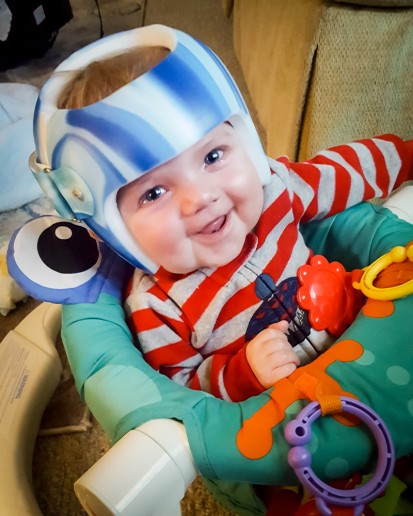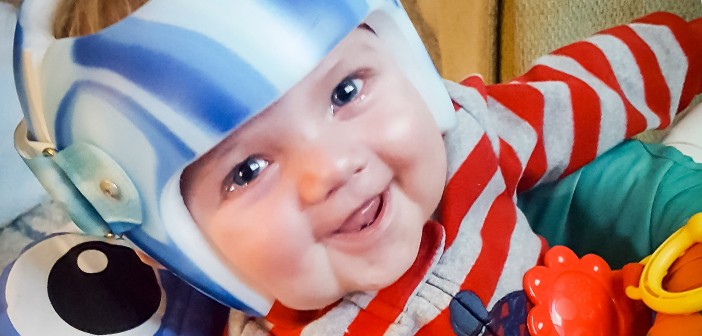Lee was born on a hot, summer day in June 2016. The blue-eyed, blonde-haired boy soon became the apple of his parents’ eyes. With Elijah and his three big brothers, his mother, Melissa Alward, is one busy mom.
At about two months old, Elijah had developed a flat spot on the back of his head. The pediatrician told Melissa to keep an eye on it and to try to keep him off his back as much as possible. “He just wouldn’t do it,” Melissa says. “He hated tummy time and would cry if he wasn’t lying on his back.”
Elijah had developed a condition called “plagiocephaly,” which is also referred to as Flat Head Syndrome. And, it has recently become more prevalent.
If your baby’s head is beginning to flatten, it is important
that you take action while he or she is still very young.
“The doctor told me that the bones in some babies’ heads are just softer, and that it is more common now because babies are positioned on their backs for sleeping to reduce the risk of S.I.D.S. [Sudden Infant Death Syndrome],” Melissa explains. “And more parents are on-the-go, so their babies spend a lot more time in car seats.”
 When Elijah was about six months old, his pediatrician sent him to see a certified orthotist to be fitted for a helmet to re-shape his skull.
When Elijah was about six months old, his pediatrician sent him to see a certified orthotist to be fitted for a helmet to re-shape his skull.
“The helmet is called a ‘cranial orthosis,’” explains Melissa. The orthotist used a cranial tape measure to measure his head – width, length, and diagonally. Then, it was determined that wearing a helmet would correct the flatness of his head.
Elijah now wears the helmet 23 hours a day and could wear it for as long as three to six months, depending on his progress. The correction is monitored and the inside of the helmet is adjusted regularly. “It’s soft inside and comfortable, and he doesn’t seem to mind it,” Melissa adds. You can even buy stickers and decals to decorate the helmet, with sayings such as, “Just Fixin’ My Flat,” or “I do all my own stunts.”
“Elijah looks cute wearing his helmet,” Melissa admits. “I think it’s best for him to wear it, but it does make it harder for me to cuddle him!”
Flat Head Syndrome
Flat Head Syndrome is very common in babies today and is estimated to affect anywhere from one-third to one-half of all babies who sleep on their backs. In many cases, it can be prevented if you have the right information. If your baby’s head is beginning to flatten, it is important that you take action while he or she is still very young. The earlier you can begin treatment, the better.
Treatment for Flat Head Syndrome will vary depending on the baby’s age and the exact condition causing the flat area. For positional plagiocephaly and brachycephaly, the first course of action is normally aggressive repositioning and lots of tummy time. Repositioning is most effective when started as early as possible, and works best when the baby is under four months old, although some parents have experienced improvement after this age. Make sure that you are varying your baby’s position so there is never consistent pressure on the same area of the head. Tummy time is so important for all babies, but it is critical to do it consistently and often if your baby is developing a flat head. If these options do not resolve the issue, a baby helmet is usually recommended.
Source: BabyFlatHead.org








